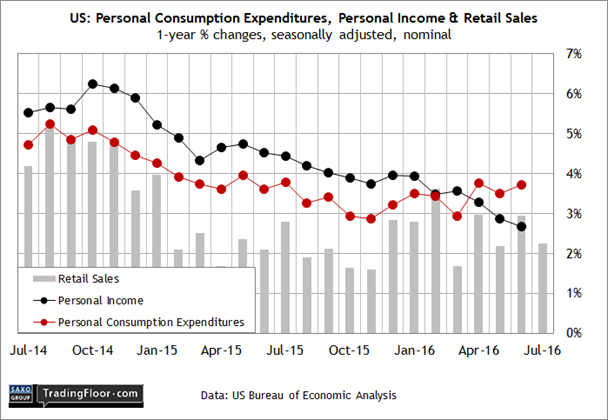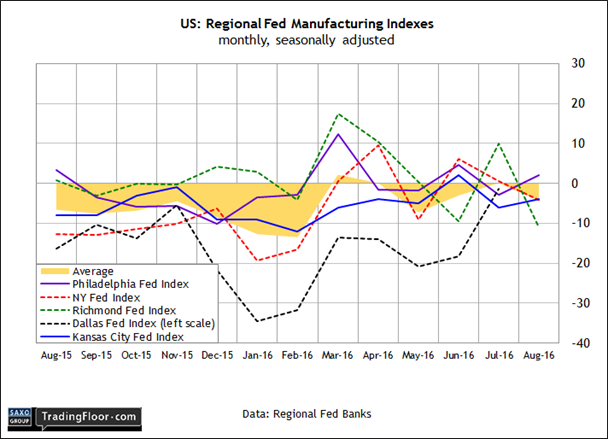- Slightly softer US consumer spending growth expected
- Is it the end of the 19-month contraction in manufacturing in the Dallas Fed region?
- Will the two-year Treasury yield continue up and point to Fed rate hike in September?
The US consumer sector is in focus today with the July report on personal income and spending. We’ll also see the monthly release of the Dallas Fed’s profile of regional manufacturing activity. Meantime, keep your eye on the two-year Treasury yield as the market continues to digest last week’s modestly hawkish comments from US Federal Reserve Chair Janet Yellen.
US: Personal Income and Spending (1230 GMT): US economic activity increased slightly less than previously estimated in the second quarter, the government reported on Friday. GDP advanced 1.1%, fractionally below the already weak 1.2% advance estimate published in late July.
One thing that didn’t change, however, is the solid acceleration in personal consumption expenditures (PCE). In fact, PCE’s second-quarter gain was revised up to 4.4% from 4.2% in the first estimate, delivering a slightly stronger rebound over the 1.6% increase in the first quarter.
The solid advance in spending implies that the positive momentum will spill over into Q3, starting with today’s PCE update for July. But that’s not what the latest retail sales data suggest. Headline retail consumption (a subcomponent of PCE) was basically flat last month, the weakest performance in four months.
“It is a bit disappointing, at least to start the quarter,” said an economist at RBS Securities. “Labour income is the key. Confidence seems to be moving sideways.”
Perhaps, but economists are still looking for a respectable report today. Personal income growth is on track to accelerate to 0.4% in July vs. 0.2% in the previous month. Meanwhile, consumer spending’s pace is projected to edge lower to 0.3% from 0.4%. In short, today’s update looks set to offer more evidence that the consumer sector’s moderate expansion will endure in the third quarter.

US: Dallas Fed Manufacturing Index (1430 GMT): The modest rebound in manufacturing activity lately looks like another false dawn, according to data for August via numbers published by regional Fed banks.
Three of the four manufacturing indices for this month are in the red. But today’s update from the Dallas Fed may break with the trend and post a positive reading for the first time in nearly two years.
The return of growth for the Dallas Fed manufacturing index is less about an early clue for the national trend than an easing of the energy recession in the bank’s region, which is relatively dependent on the oil industry.
Although the oil patch is still suffering, the rebound in energy prices this year has brought a degree of relief. A barrel of West Texas Intermediate, the US benchmark, traded at nearly $48 on Friday — a gain of nearly 30% for the year-to-date comparison.
The return of growth to the Dallas Fed region’s manufacturing sector would be welcome news, but for the moment a firmer trend isn’t expected to translate into robust activity for this slice of the economy on a national basis. US manufacturing growth slipped to a four-month low in August, according to survey data.
“The August drop in the PMI is a disappointment but less worrying when looked at in the context of July’s better than expected reading,” the chief business economist at IHS Markit said last week. Taking the July and August readings together suggests that manufacturing is enjoying its best growth so far this year in the third quarter, and should help drive stronger GDP growth.
That’s a debatable point, but an encouraging update in today’s Dallas Fed release will certainly boost the case for expecting moderately stronger comparisons for manufacturing generally in this year’s second half.

US: 2-Year Treasury Yield: US Federal Reserve Chair Janet Yellen last week said that “the case for an increase in the Federal funds rate has strengthened in recent months.” Speaking at the central bank’s annual Jackson Hole, Wyoming summit, she noted the “continued solid performance of the labour market and our outlook for economic activity and inflation” as key factors for anticipating that policy would be squeezed at some point in the near future.
Yellen’s comments boosted the probability that we’ll see a rate hike at next month’s Federal Open Market Committee (FOMC) meeting, based on Fed funds futures. At the end of last week, the implied market estimate for a higher policy rate increased to 33%, up from 15% at the start of the week. The crowd is still betting on no change at the September 20-21 meeting, but the possibility of a surprise is no longer priced as extremely unlikely.
Meantime, the Treasury market is pricing in moderately higher odds for a rate hike. The 2-year yield, which is considered highly sensitive to rate expectations, ticked up to 0.84% on Friday – the highest in nearly three months, based on daily data from Treasury.gov.
Reacting to the rise, a senior government-bond strategist at CRT Capital told The Wall Street Journal that “the market is acknowledging the fact that the Fed really wants to hike.”
If investors are motivated to continue lifting the probability of a rate hike for next month, a higher two-year yield this week will offer an early clue.

Disclosure: Originally published at Saxo Bank TradingFloor.com
